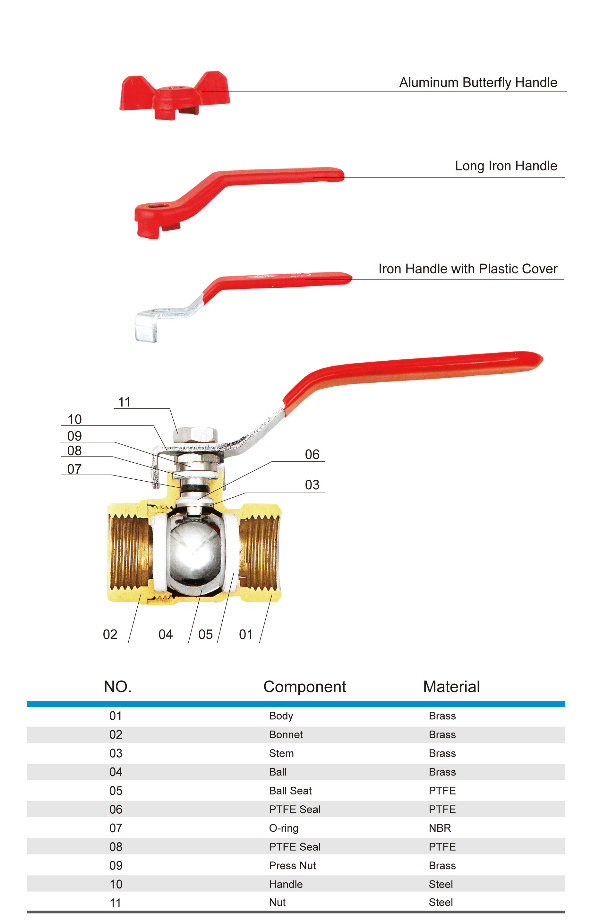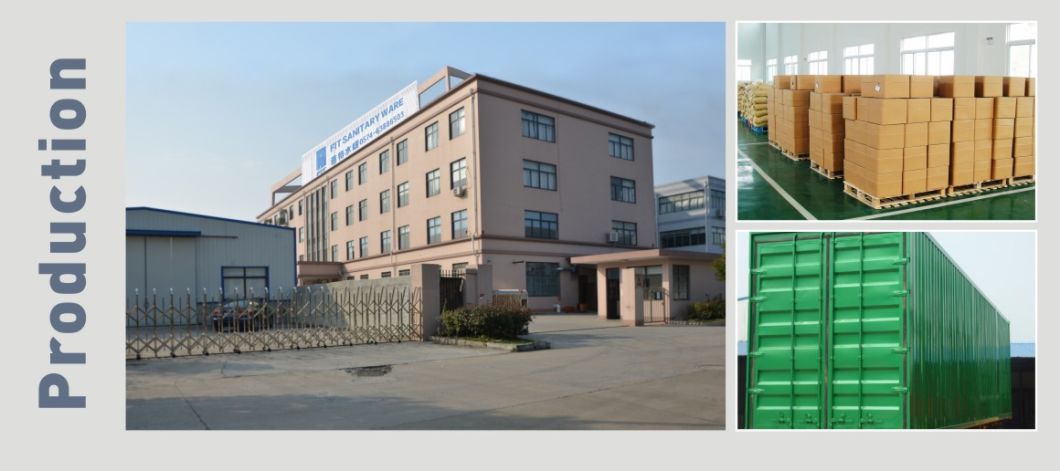Model NO.: MF11001
Structure: Fixed Ball Valve
Type: Fixed Ball Valve
Function: Bypass Valve
Temperature: Normal Temperature
Application: Industrial Water Systems
Trademark: FIT
Transport Package: Standard Carton Box
Specification: 3/8" to 4"
Origin: Ningbo, China
Dn25 Lockable Ball Valve with Long Handle - Forged Brass Ball Valve (MF11001)Brass Ball Valve with Red Steel Flat Handle, Full Bore, F/F
Size: 3/8" - 4"
This high-quality brass ball valve is designed for reliable performance in industrial water systems. It features a full bore design, ensuring minimal flow resistance and efficient operation. The red steel flat handle provides a secure grip and easy operation. Available in sizes ranging from 3/8" to 4", it's ideal for various applications. Key Features: - Brass body, ball, and stem for durability - Full port design with female thread connections - Yellow steel handle for visibility and ease of use - Nickel-plated finish for corrosion resistance Materials Used: - Nut: Brass - Handle: Steel - Washer: Brass - Packing Ring: Brass - Stem: Brass - Seat Ring: Teflon - Ball: Brass - Bonnet: Brass - Body: Brass Specifications: - Nominal Pressure: 2.0MPa - Suitable Media: Water, non-corrosive liquids, saturated steam - Thread Standard: ISO 228-1:2000 - Anti-oxidation glue used between body and bonnet - Nickel-plated and full port design

As a leading manufacturer of premium ball valves, we specialize in producing a wide range of products including boiler valves, mini ball valves, gas ball valves, radiator valves, filter valves, safety valves, air vent valves, and more. Our valves are made from high-quality materials such as C37700, CW617, CZ132, CW602N, DZR, C36000, HPB57-3, HPB59-1, and are produced using advanced forging techniques. Surface treatments include brass, nickel-plated, and chrome-plated finishes. We offer prompt delivery within 25–30 days for 1–3 containers. Packaging options include polybags and cartons. Payment terms include T/T and L/C at sight. Our loading ports are located in Shanghai and Ningbo.

**FAQ** Q1: What is the warranty period? A: 2–5 years depending on the product standard. Q2: What is your minimum order quantity (MOQ)? A: Normally 500–2000 pcs per item. Trial orders and special requests can be negotiated. Q3: How long is the delivery time? A: Typically 35–45 days. Q4: Can I get samples to check the quality? A: Yes, we can provide samples at mass production cost, and the sample fee will be refunded upon placing an order. Q5: How long does it take to arrange samples? A: Usually 7–10 days. Q6: What are your payment terms? A: 30% T/T in advance, 70% before shipment. Also accept irrevocable L/C at sight. Q7: Do you offer OEM services? A: Yes, we have extensive experience in OEM production. Q8: What certifications do you have? A: CE, ACS, ROHS, REACH, WRAS certificates available. Q9: Can I visit your factory? A: Absolutely! It takes about 1.5 hours from Ningbo Airport and 30 minutes from Yuyao Train Station. We can arrange transportation for you. Q10: What is your monthly production capacity? A: 15–20 containers per month. Q11: How large is your factory? A: Approximately 4000 square meters. Q12: Which shipping ports do you use? A: Ningbo Port primarily. Q13: What is your packing method? A: Standard neutral white boxes and brown cartons. Custom branded packaging is available upon authorization. Q14: How do you maintain long-term relationships with customers? A: By delivering consistent quality and competitive pricing, and by treating every customer with respect and sincerity, no matter where they are from.
Block heat exchangers are compact, modular heat exchange devices classified based on materials, structural designs,
application scenarios, and manufacturing processes. the structured summary of classification as below: Classification by Material
1. Graphite Block Heat Exchanger - Structural Features: Made of impregnated or molded impervious graphite, offering high corrosion resistance and
thermal conductivity. Common types include cylindrical block-type (e.g., Cylindrical Block Graphite Heat Exchanger)
and shell-and-tube graphite heat exchangers. - Applications: Ideal for corrosive media like strong acids or alkalis, such as heat exchange in phosphoric acid production. 2. Ceramic Block Heat Exchanger - Structural Features: Fabricated from monolithic ceramic blocks with elongated cross-sectional channels. The overlapping
arc-shaped channel walls enhance fluid flow efficiency. - Applications: Suitable for high-temperature or high-wear environments in chemical and energy industries. Classification by Structural Design
1. Block-and-Hole Heat Exchanger - Composed of multiple perforated graphite blocks stacked together, allowing fluid exchange through interconnected channels (e.g., *Cylindrical Block Graphite Heat Exchanger*). 2. Shell-and-Tube Block Structure - Modular shell-and-tube designs, including fixed-tube and floating-head types. Examples include *Complex Shell-and-Tube Graphite Heat Exchanger*. 3. Monolithic Block Heat Exchanger - Single-piece structures formed by casting or injection molding, eliminating welds and enhancing pressure resistance (e.g., ceramic or metal monolithic blocks). Classification by Special Functions
1. High-Pressure Thread-Locked Ring Heat Exchanger - Design Features: Employs threaded locking rings for sealing, suitable for high-pressure hydrogen environments (e.g., hydrogenation reaction systems). Corrosion resistance is improved via optimized materials like hydrogen-resistant steel. 2. Corrosion-Resistant Block Heat Exchanger - Examples include *Double-Side Corrosion-Resistant Cylindrical Block Graphite Heater*, designed for strong acid media. Classification by Manufacturing Process
1. Modular Assembly Type - Multiple modules connected via bolts or adhesives, facilitating maintenance (common in graphite heat exchangers). 2. Integrated Monolithic Type - Molded in one piece for high structural integrity, such as cast ceramic or metal blocks. Application Scenarios
- Chemical Industry: Graphite and ceramic block exchangers handle corrosive media (e.g., sulfuric acid, phosphoric acid). - Energy & High-Pressure Systems: Thread-locked ring exchangers are used in petroleum hydrogenation and high-pressure steam systems. - High-Temperature Environments: Ceramic blocks excel in waste heat recovery from high-temperature exhaust gases.
block, block heat exchanger, heat exchanger
Siping Juyuan Hanyang Plate Heat Exchanger Co., Ltd , https://www.tj-heatexchange.com
